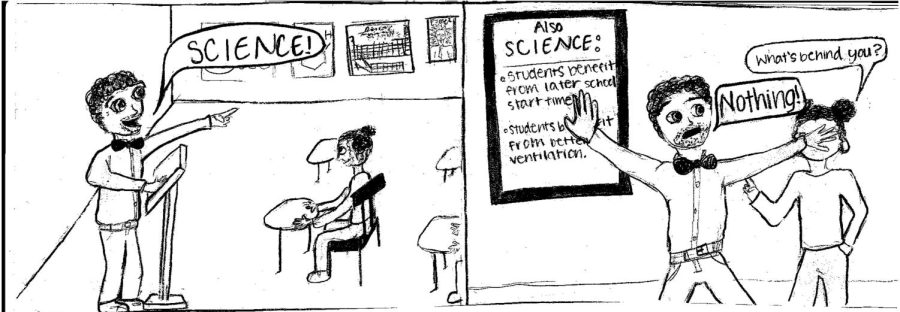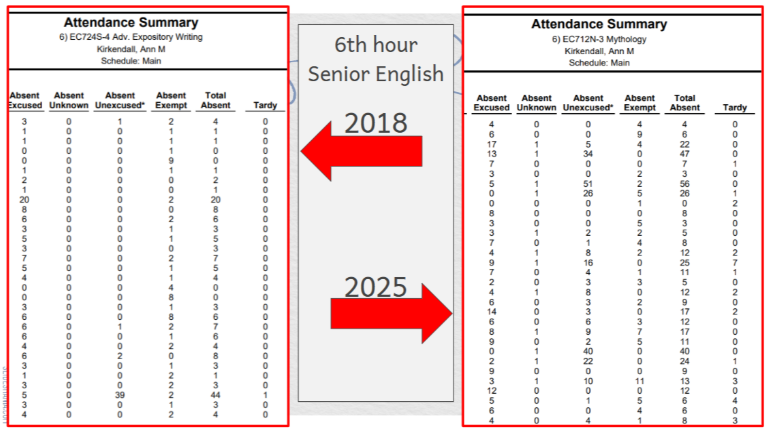So…do we believe in science or no?
May 13, 2022
The benefits of public school are undeniable. Nonetheless, experts and prominent organizations have been suggesting changes for a better scholastic environment. Even though every school has science classes, schools fail in listening to it.
Science supports a longer school lunch; most schools provide 30 minutes or less
The most debated issue is having longer school lunches. “The 25 minutes to half hour is too short” says the School Nutrition Association and experts on the issue. “Too short lunch periods disproportionately harm low-income students, for whom school lunch may be their most reliable and hearty meal of the day, especially affected by the time they spend in line waiting to be served.”
The president of the School Nutrition Association, Gay Anderson, explained how the length of school lunch periods has stayed the same over the past decade, but the student population has been growing. Consequently many schools have more students in the cafeteria–which means less time for eating. By the time students reach the cafeteria, go to the bathroom, serve themselves, wait in line, and sit down, a big chunk of the original 25/30 minutes lunch period is gone.
West Ottawa provides 30 minutes for its lunch period. Holland Christian has a 30 minutes break too, together with Holland High School.
About this issue, a WO science teacher, Mr Dennis, trying to explain schools’ hypocrisy, said: “We could make the lunch longer, but we should extend the school day for how many hours are required. If we would end high school ten minutes later, it would affect the bus transportation, and it could cause kids from elementary school to not get home until 5pm”.
Science supports a later school start; 93% of American high schools start before 8:30 am
Another issue is the start time of middle and high school. According to the 2014 School Health Policies and Practices Studies, 93% of high schools and 83% of middle schools in the U.S. started before 8:30 a.m.
The American Academy of Sleep Medicine has recommended that middle and high schoolers need between 8 and 10 hours of sleep. School start at 8:30 a.m. or later would give students the opportunity to get the sleep they need.
Cultural expectations have a role too. Middle and high schoolers are expected to take part in extracurricular activities, such as clubs, jobs, and sports. Those activities often take place in the evening. At those times many students will still have homework to do or will stay on their phone until late. Instructor Dan Dennis said: “School starts early so that kids can work and be in sport. I think they should go to bed early; it’s not about when you wake up, but when you go to bed. And then kids sleep with their phone in the room, which interferes with sleep, or they stay up until late. A shift in the school start time would reduce the time of daylight that students have, particularly important for playing some outdoor sports, such as tennis or softball. A later school start would cause reduced opportunities, it would be harder for parents’ schedules, and increase transportation’s costs”
Not getting enough sleep consists in a higher risk of:
- Being overweight
- Drinking alcohol
- Smoking tobacco
- Using drugs
- Struggling on focusing; poor academic performance and lower grades
- Participating in risk-taking behaviors, such as bullying and fighting
- Athletic injury
- Depressive symptoms and suicidal ideation
- Motor vehicle accidents
A later school start time showed many benefits, such as decreased tardiness, better graders, improved attendance, fewer students falling asleep in class, fewer disciplinary issues, and a decline in motor vehicle crashes.
Many studies have been made comparing the number of vehicle crashes in counties with different school start times. One study by the National Library of Medicine showed a 16.5% decrease in the teenage crash rate after a 1 hour delay on the school start time.
Our schools, including West Ottawa, which start at 7:45, ignore science. The hypocrisy is blatant.
Science supports a better ventilation in classrooms; school don’t have/don’t allow to open windows
Infrastructure, in remote areas, allows students to study. Factors like adequate spaces, appropriate temperatures, lighting, and ventilation, and good water, electric, and internet systems, as well as clean and functional sanitary services, tend to improve student and teacher’s interest in learning.
According to CAF, schools struggle in particular with appropriate ventilation. With up to 30 students in a class, it’s easy to imagine how polluted the air is. Cleaning products, sprays, and glues contribute to the poor atmosphere in the class. It also exposes teachers and students to harmful contaminants from new furniture and other sources of toxic gasses.
Let aside during the pandemic, according to Dr. Shamila Haddad, poor air quality can significantly harm student and teacher’s health if exposed to it for a long period of time. In fact, it heightens the risk of the transmission of airborne disease (like COVID) or produces lifelong issues such as respiratory infections and airways disorders. Other effects could be:
- A reduced attention span
- Increased tiredness
- Drowsiness
- Lack of concentration
- Headaches
- Fatigue
- Irritation of nose and throat
- Coughs
A better filtration system would improve student’s concentration and productivity and decrease the risk of exposure to those health issues.
Instructor Dan Dennis said: “The ventilation problem is fixable; it does not require windows, considering that the best ventilation is on airplanes, but filters and air handlers–but those require money. Between better air quality and money the society had deemed the answer is no–it’s not worth it; same with the other things that science says.”
There’s much confusion about why school ignores such compelling science, but Dennis said: “I think the reason it’s economic.”
All those arguments are available with a quick research online. Many experts, professors, scientists, and researchers showed how schools harm students and teachers’ health.
What stands out the most is the ease with which these changes could be made–and the pros significantly outweigh the cons. Just thinking how shifting by an hour the school start time could decrease the number of motor vehicle crashes, protecting and helping the community and students well being. It’s definitely worth the change.
It is ironic then how schools teach science but at the same time manage to ignore it.




